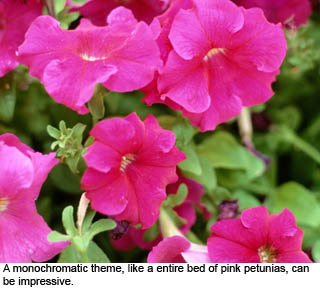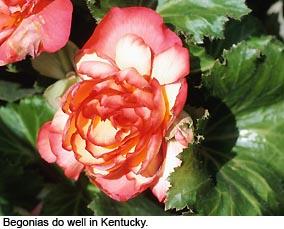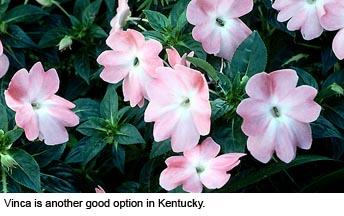Time to Plant Annual Flowers (Again) Nearing
Time to Plant Annual Flowers (Again) Nearing

To those who planted flowers early this year, only to watch them succumb to the four-day freeze in early April: Take heart. There’s still plenty of time to create a summer full of color for your yard or garden.
In fact, said Sharon Bale, floriculture specialist with the University of Kentucky Cooperative Extension Service, the best time for planting annual flowers in Kentucky has yet to arrive.
“In central Kentucky, at least, it is after May 10 … and you can plant many of them well up into June,” she said.
Many Kentuckians think Derby Day, the first Saturday in May, signals the start of the flower-growing season in the state. But even that is a bit early, Bale said. Instead, May 10 is the day after which such popular warm-season flowers as fibrous begonias, impatiens and vinca can be planted without the risk of a return visit from Jack Frost.
“That’s the way it is here. The warm weather just messes with people’s minds, and they get geared up and get excited. They don’t believe this (a damaging frost) is going to happen, but it does happen,” Bale said.
 Waiting to plant warm-season flowers until the risk of a freeze has passed is only one of several suggestions Bale regularly shares with Kentucky gardeners to help them get the most out of their flower gardening experience. Another point she emphasizes is to first “consider what you want to do.”
Waiting to plant warm-season flowers until the risk of a freeze has passed is only one of several suggestions Bale regularly shares with Kentucky gardeners to help them get the most out of their flower gardening experience. Another point she emphasizes is to first “consider what you want to do.”
“If you’ve got a flower bed out in your front yard that you want to impress the people who are driving by, to show them that you’ve got plenty of color, you probably need to stick to a monochromatic theme – pink begonias, for example – to give you that display. Such low-maintenance flowers as begonias are also probably the best choices when you want to show off for your neighbors,” Bale said.
On the other hand, if you’re not interested in having a “showy” flower garden but want to have flowers to cut and display, plant the flowers in an inconspicuous place.
“If you want a cut flower garden, then you need to go some place besides your front yard because a lot of those flowers that are good for cuts are not necessarily showy for what you want to do,” Bale said.
 As far as choosing which flowers to plant, she often tells people to stick with those that do well in Kentucky – again, fibrous begonias, impatiens and vinca, as well as periwinkle and petunias.
As far as choosing which flowers to plant, she often tells people to stick with those that do well in Kentucky – again, fibrous begonias, impatiens and vinca, as well as periwinkle and petunias.
“The list doesn’t change that much because flowers that do well in Kentucky always do well in Kentucky,” she said.
But, Bale adds, don’t be afraid to try different things with them. One increasingly popular technique is to plant a large container with a mix of flowers.
Bale, an All-America Selection judge who helps select which new flower cultivars win national acclaim, is hesitant to mention new cultivars to people until she and her extension colleagues are able to see how they perform in Kentucky for at least three years.
“Because we’re tough. We’ve got every disease known to man. In a summer season we could get every type of climate that’s going to promote those diseases. Bugs are an issue. We’re up, we’re down in temperatures,” Bale said.
Besides, there are so many new plants available, local greenhouses and nurseries may have difficulty stocking the newer cultivars, she added.
One type of plant Bale likes to encourage people to try is not really new, nor is it a flower. It’s a sweet potato.
“Breeders started recognizing these (sweet potatoes) with different colorations and they moved from a food source into an ornamental,” she said.
Swiss chard, which is also “very beautiful in the garden,” is another vegetable that is making the move to the ornamental side, she said. So is the leek, which has long been admired for its vertical shape.
Regardless of the types of flowers you plant, Bale said the important thing is to “have fun with them. … Do the best you can and if it works, it works. If it doesn’t, then don’t get upset.”
On the more practical side, Bale advises new and veteran gardeners alike to choose flowers for a flower garden as they would choose vegetables for a vegetable garden. Plant cool-season flowers in the spring, plant warm-season plants after the last freeze date, and come back in the fall with more cool-season plants.
Likewise, flower gardens require fertilization similar to vegetable gardens. “If you get the flower gardens up to the same level of fertilizer as the vegetable garden recommendations, you’re good to go,” she said. However, when using containers, the flowers will need to be on a regular fertilization program. The safest bet with fertilizer is to get a soil test at the local Cooperative Extension Service office.
During the growing season – especially during periods of drought – make sure the plants get adequate water. Amounts and timing will vary according to the soil and drainage level.
“Pay attention to what the plants are telling you,” Bale said. “Some plants will tell you when they need to be watered because they will wilt.”
If flowers are planted in containers, the amount and timing of watering is dependent mostly on the size of the container. Small pots will need watering more often. During periods of dry weather, they may need to be watered as much as twice daily, Bale added.
In either case, “regularly monitor the plants to keep problems from sneaking up on you,” she added.
For more information about growing flowers in Kentucky, contact your local extension office or visit the UK College of Agriculture Web site. A variety of publications, including “Low Maintenance Annual Flowers for Kentucky Gardens” (HO-47), and other gardening information are available.
